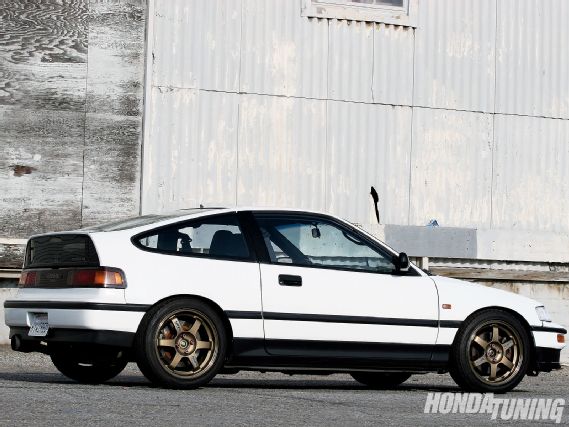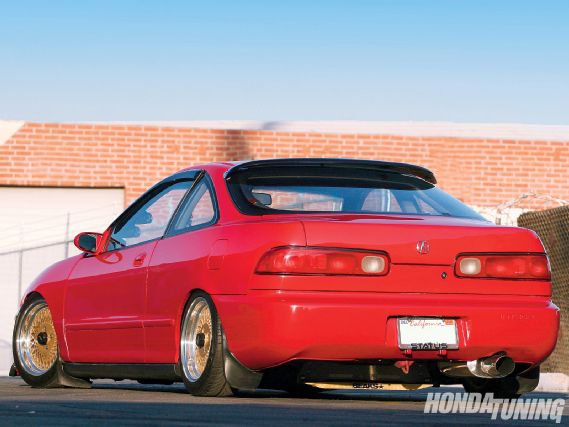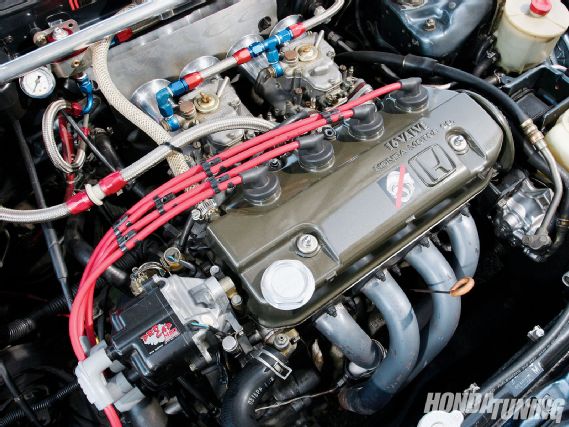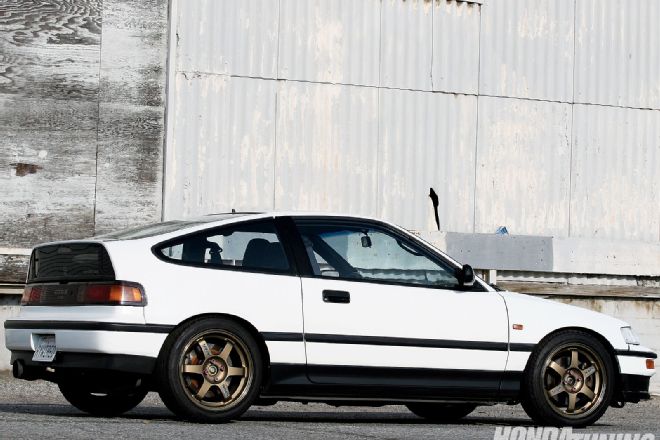Questions Answered By Honda Expert, Ryan Basseri Of Rywire www.rywire.com
So I was reading your online article about API dropping a J35 into an EG. Would this be legal in California? CARB states that the engine must be from the same type of vehicle. Since the engine is from the Odyssey, wouldn't this be illegal? Well, I was just curious what would be the BEST J series swap I can do to my EG and still be CA legal. Perhaps a J32 motor? Thank you in advance for your time.
K.D. DelaCruz
The first problem with a J35 in California is that it may be in the truck engine category, making it totally illegal. The BEST choice is probably the J32, as it makes great power, and is found in a car of the same maker. Technically, if you can get the car to run with no codes, all the smog equipment installed, and proper matching U.S. spec ECU installed, it can be Ref'd in the state of California.
Hey Guys, thanks for putting out a great magazine, it's the only one I subscribe to and I love it!
I have a 91 CRX that I'm thinking of cramming the big block H22A into, but of course there is a lot to think about. First off, do you guys know the weight of an H22A long block and tranny? Second, is there an aftermarket intake manifold for the H22 that is shorter than stock so I don't have to beat the heck out of my firewall to make room for it? What would you guys think if I were to boost the H22 on a small 16g turbo at stock levels of say 10 lbs? Would that be safe with the FRM liners and stock pistons/rods? Should I upgrade to Mahle pistons and aftermarket rods, or would it be best at those boost levels to go with an iron sleeved block and forged pistons/rods? Lastly, who would you guys recommend to machine my H22? I don't think anybody in my town has experience with many built Hondas, let alone FRM lined ones.
Davey Peters
Central Point, OR
 |
1991 Honda CRX - Exhaust Notes
|
1991 Honda CRX - Exhaust Notes
Davey, an H22 in a CRX is a cool swap, but in my mind it's really only good as a drag setup. The main reason I feel this way is because it hardly fits in the engine bay, and you cannot set it up in a way that allows you to close the hood while still running a proper axle alignment. The weight difference is not a huge concern; it weighs more but once you upgrade the springs you won't even notice. But if that's what you're after, the main thing I would consider before doing the swap is running an H transmission, or converting to the B transmission with the adapter plate. The who that convert to the B are doing so for the tighter gears, clutch choices, axle angle, and better resource of parts. Many of my customers decide to run the Skunk2 intake manifold with a chipped obd1 ECU. Its single runner design eliminates the butterflies so tuning is necessary. Turbos are a great addition if you are looking to make some serious power! If you are only looking to run low boost you shouldn't really need to do any serious engine internals if you don't want to. A good tuner should be able to make you some good safe power.
Hey Honda Tuning, I was just wondering what the fitting size is on the front and rear calipers on an EK with a swapped disc out back. I didn't know if it was 10mm x 1.00 or not. I can't seem to find anything on the net. Oh yeah, also the IFM fitting that goes into the rubber line; I'm swapping the brake lines with ones that I found in a racing magazine and it's so much cheaper. Thanks a mil.
Corey
Hampton, VA
If I understand you correctly Corey, you're asking about the thread pitch for the brake line into the calipers. It should be an M6X1.0 - (The M stands for metric, 6 is the size, and 1.0 is the thread pitch).
I was on the way to work, after which I was to meet the buyer for my '97 Civic sedan. I stopped by a local store to pick up a magazine before work. I had read your magazine a couple times and love the articles, so I flipped through your august '09 issue and saw the Mugen-equipped '97 sedan featured. I immediately called the buyer and told him the deal was off! After work I ordered a pair of Bride Vios seats, and so the project begins! It is my first car and have concerns about its motivation. Should I swap the Y7 for a B16 or swap it to a manual tranny and just turbo the Y7?
John Kaufman
Louisville KY
Good decision on keeping the Civic John. You know, single cams are cool motors, but to me, the B series engine just has so much more potential for the long run. You have to think about future modifications and options, and having a good base to work off of can make a world of difference. I know it's a tough decision, but why not start out with something that already packs a decent punch, and build on it...
Love the magazine and I think your articles are more informative and down to earth regarding Honda/Acura lovers than those other import magazines. I own a '92 Acura Integra GS-R that currently has a 1.5 SOHC engine that's locked up (drove thru a water puddle-STUPID ME). I want to replace it with something that can produce around 200whp. What engine swap would be best? What type of ECU, axle, linkage, exhaust, etc? And come to find out after reading your article on the '93 DB2 Integra how rare this ride is; leather interior, power interior, sunroof, etc. I refuse to just get rid of it. This will be my first project car and I want to do it right the first time with authentic Mugen & aftermarket parts. I'm located in S***t hole Yuma Arizona and there aren't shops setup for customers looking to "TUNE or DIE".
Milton Jones
Yuma AZ
 |
1991 Honda CRX - Exhaust Notes
|
1991 Honda CRX - Exhaust Notes
Alright Milton, since your car is a GSR already, you should have no problem swapping in another B series engine. I suggest a 1.8 (LS/RS/GS block and VTEC head) or a 2.0 B20 (CRV block and VTEC head). Both of these engines will make close to 200whp with bolt-on parts and light work. If your car currently has a SOHC motor in it, someone must have put that in before they sold you the car. You will have to source some original OEM parts to get this car back to B series. Namely, B series motor mounts, shift linkage, ECU, and cat-back exhaust.
What's up HT! I've been reading your mag for a minute and I love it, keep it up! I just bought a '98 Civic DX 5-speed. The engine is stock, with over 137K on it. I don't want to do an engine swap if possible; I'd rather just rebuild the stock one. I don't want to race it, I just want a daily driver but I also want some power. Am I better off just giving in, and swapping the motor, or could I make some power rebuilding it? I plan on installing a cold air intake and exhaust system, but might want a little more power in the end. Thanks, and keep up the good work.
Wil Bronx
New York
It's pretty common to be power hungry even with a daily-driven car! If it were me, I would consider two directions: The first, keep it clean and simple, and rebuild the stock motor. You'll get great fuel economy and enjoy a stress free car that can go a long way on a single tank. You can add intake, header, and exhaust if you want, and squeeze the max efficiency out of her. The second direction you can take with the car is a motor swap. You can go with something like a B16a; it will still maintain excellent fuel economy and the 160hp under the hood would make for some good times on the back roads when you feel the urge to get on it!
HT!!!! Love the mag!! I'm building a '91 CRX, and since Rywire is the man when it comes to engine bay tucking, I have a question for him. I keep seeing really nice engine bays that don't have a brake booster under the hood. It looks like they have a reservoir and a bulk head, but the big black disc is nowhere to be found. How are they doing this, and is it safe for a car that is actually driven regularly? I'd love to eliminate my booster and finish cleaning up my engine compartment, but I don't understand how this works. Help me out Rywire!!!!
Ronnie
Nebraska
Ronnie my man, I'm glad you asked this question. This happens to be a product that I sell on the side, however it is not a great idea on a daily driven car just yet. The booster is a vacuum assist that uses engine vacuum to boost the pedal pressure so the driver doesn't need calves of steel. Having no booster is essentially manual brakes, however, even race cars and old classic cars with manual brakes have the correct pedal ratio based on the size of the car and ratio of the master cylinder sizing. For our Honda pedals, the best master cylinder size I have found so far is a 3/4, but all the master cylinder manufacturers I have seen have a single outlet for only front wheel brakes. I have seen people use the single outlet and tee it from the single line to both inputs on the Honda prop valve. I do not like this idea because if you lose the master, you lose all 4 brakes at once rather than just two. You can use a factory master cylinder with dual outlets, but the smallest Honda master I have seen is the 13/16th and this is still too large for proper stopping. What we need is to have a company like Wilwood make a dual outlet diaphragm in a small-sized 3/4 master.
I've got a question; I have a '96 Civic DX, I'm pondering installing the f2d kit into. I understand that the driver's side mount will need modification as well as other mounts, which is fine with me. Where can I find rods and pistons, relatively inexpensive, for the F23 or F22? I can't seem to find many options. Can the F23a use K20 forged internals? If so, what type?
Joey
Funtucky, CA
 |
1991 Honda CRX - Exhaust Notes
|
1991 Honda CRX - Exhaust Notes
The best guy to talk to about this would be Bisi at Bisimoto Engineering. He has built some of the fastest single cam engines in the world, and loves the F-series with a passion! He has access to all types of pistons and other goodies for your F series motor. Tell him Rywire and Honda Tuning sent ya!
I have a question about the 500hp B16 with just a turbo, pistons, and a few other upgrades. I'm wondering how the air-to-water intercooler will fit in the car. It appears to me that the radiator will be in the way. Just wondering what modifications you would have to do.
James Dunn
Florida
You can basically route it wherever you can find space for it. I suggest putting it behind the passenger side headlight as I've seen it mounted there in the past and it seemed to be a perfect fit.

